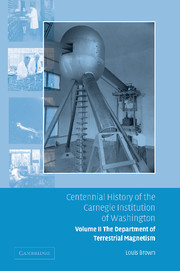Book contents
- Frontmatter
- Contents
- Foreword by Richard A. Meserve
- Preface
- 1 Establishment
- 2 Cruises and war
- 3 Expeditions
- 4 Measurements: magnetic and electric
- 5 The Fleming transition
- 6 The last cruise
- 7 The magnetic observatories and final land observations
- 8 The ionosphere
- 9 Collaboration and evaluation
- 10 The Tesla coil
- 11 The Van de Graaff accelerator
- 12 The nuclear force
- 13 Fission
- 14 Cosmic rays
- 15 The proximity fuze and the war effort
- 16 The Tuve transition
- 17 Postwar nuclear physics
- 18 The cyclotron
- 19 Biophysics
- 20 Explosion seismology
- 21 Isotope geology
- 22 Radio astronomy
- 23 Image tubes
- 24 Computers
- 25 Earthquake seismology
- 26 Strainmeters
- 27 The Bolton and Wetherill years
- 28 Astronomy
- 29 The solar system
- 30 Geochemistry
- 31 Island-arc volcanoes
- 32 Seismology revisited
- 33 Geochemistry and cosmochemistry
- 34 The Solomon transition
- 35 The support staff
- 36 Epilogue
- Notes
- Index
25 - Earthquake seismology
Published online by Cambridge University Press: 06 January 2010
- Frontmatter
- Contents
- Foreword by Richard A. Meserve
- Preface
- 1 Establishment
- 2 Cruises and war
- 3 Expeditions
- 4 Measurements: magnetic and electric
- 5 The Fleming transition
- 6 The last cruise
- 7 The magnetic observatories and final land observations
- 8 The ionosphere
- 9 Collaboration and evaluation
- 10 The Tesla coil
- 11 The Van de Graaff accelerator
- 12 The nuclear force
- 13 Fission
- 14 Cosmic rays
- 15 The proximity fuze and the war effort
- 16 The Tuve transition
- 17 Postwar nuclear physics
- 18 The cyclotron
- 19 Biophysics
- 20 Explosion seismology
- 21 Isotope geology
- 22 Radio astronomy
- 23 Image tubes
- 24 Computers
- 25 Earthquake seismology
- 26 Strainmeters
- 27 The Bolton and Wetherill years
- 28 Astronomy
- 29 The solar system
- 30 Geochemistry
- 31 Island-arc volcanoes
- 32 Seismology revisited
- 33 Geochemistry and cosmochemistry
- 34 The Solomon transition
- 35 The support staff
- 36 Epilogue
- Notes
- Index
Summary
Two sources of seismic waves are used to study the Earth's structure: explosions and earthquakes. The magnitudes of the former are generally restricted to what can be obtained from one to several tons of chemical explosive, when the cooperation of mining and quarrying companies can be secured. Nuclear explosions can increase the energy release, but they are relatively rare and cannot form a reliable basis for an extended research program. Earthquakes provide waves capable of exciting seismometers located around the world, but the simple, straightforward results obtained from the explosion studies initiated in 1947 contrast with the difficulties faced in making use of the natural sources.
The explosion work allowed the source to be accurately located in space and time and the recording instruments to be positioned to take advantage of this knowledge. Earthquakes are distributed primarily – and fortunately – in restricted regions, and seismometers must be located where stations can be operated and maintained continuously, awaiting the arrival of unpredicted waves. Such a network was beyond the capability of the Department, but it could make use of the World Wide Standardized Seismograph Network (WWSSN) operated by the US Coast and Geodetic Survey, whose data were available to all. This network, a consequence of the Department of Defense's need to monitor nuclear explosions, proved to have enduring scientific value.
The Department's earthquake research had been initiated by the creation of the small network of stations in the Andes that resulted from the 1957 participation in the International Geophysical Year.
- Type
- Chapter
- Information
- Centennial History of the Carnegie Institution of Washington , pp. 187 - 194Publisher: Cambridge University PressPrint publication year: 2005



